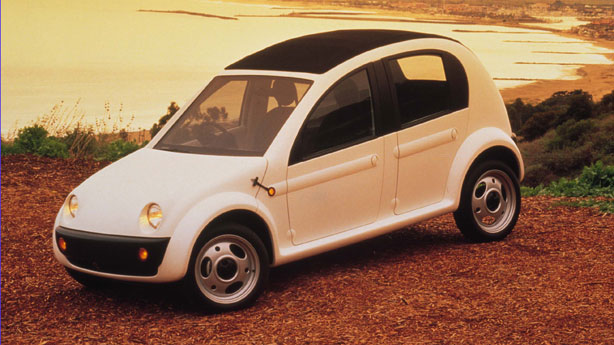
Back in the good old days, when Chrysler prided itself on showing the absolute coolest concept cars in the business -- and then building them -- there was one outlier. The Chrysler CCV was alternately referred to as the "Crazy Concept Vehicle" or "China Concept Vehicle," but that first "c" actually stood for "Composite," which is a fancy word for plastic. Aping the Citroen 2CV in both looks and purpose, the CCV wasn't about styling like the typical Chrysler concept of the era, it was about materials. See, the revolution this unattractive lump of a car promised was to free the emerging world from the dual tyrannies of metal and paint. The CCV was to be built almost entirely from plastic. For years cars had employed plastic body panels (think: Corvette and Saturn). But what Chrysler planned to do was truly crazy: Build the whole darn thing from plastic, using four large pieces that would be glued together to form nearly the entire structure of the car. (The CCV would have also had a tubular steel frame bolted to the undercarriage, to increase its load-bearing capacity.) These pieces would have been some of the largest injection moldings ever created, using cutting-edge manufacturing technology.
The "body-in-white," as this basic structure is referred to in the auto industry, would have weighed just over 200 pounds, and the complete car would have tipped the scales at just 1,200. By comparison, a Smart fortwo weighs in at 1,808. The low weight of the body meant the suspension components and wheels could be downsized, and it also allowed the CCV to employ a lawnmower engine and still achieve reasonable speeds. (Chrysler said the car would top out at around 70 mph.)
But that's just the beginning. The CCV had no separate interior, as these details were just molded into the back of the exterior panels. And the car wouldn't have had to be painted, since color would be molded into the plastic. These advantages represented a huge savings for Chrysler, which would have been reflected in a low purchase price for the CCV. It also made the manufacturing process far greener. (Even today, paint is one of the major sources of environmental concern in auto manufacture.) Further green cred came from the complete recyclability of the plastic body, which could have been ground up and melted down just like so many plastic milk jugs.
The whole idea was so simple in design and execution that the resultant car was deemed perfect for markets like China and India, where it was assumed that people would leap at the opportunity to own any sort of motorized transportation. Of course, like most perfect plans, this one didn't exactly come together. What did happen was that Chrysler was eaten up by the Germans at Daimler-Benz, who had little interest in this glorified golf cart. The injection molding processes continued to evolve, and at one point Chrysler was planning on using the technique to build the removable hardtop for the Jeep Wrangler. The CCV's chief designer, Bryan Nesbitt, went on to fame and glory for designing the curiously similar looking Chrysler PT Cruiser before entering the Bermuda Triangle of employment at GM, where he still works. As for the Chinese, well, apparently nobody in 1996 thought to ask them what they'd like to drive: Volkswagens and Buicks were their top-sellers last year.


Sign in to post
Please sign in to leave a comment.
Continue